The unusual properties of tiny particles contain huge promise. But nobody knows how safe they are. And too few people are trying to find out
Bạn đang xem bản rút gọn của tài liệu. Xem và tải ngay bản đầy đủ của tài liệu tại đây (283.35 KB, 18 trang )
Center for Nanotechnology in Society
University of California, Santa
Barbara
www.cns.ucsb.edu
WEEKLY CLIPS
November 19 - 26, 2007
Weekly Clips from CNS-UCSB are now available online:
/>
November 22, 2007
A little risky business
The unusual properties of tiny particles contain huge
promise. But nobody knows how safe they are. And too
few people are trying to find out
Waving a packet of carbon nanotubes accusingly at the assembled
American politicians during a hearing last month in Congress, Andrew
Maynard was determined to make a point. The nanotechnology expert
at the Woodrow Wilson International Centre for Scholars in Washington,
DC, had bought the tiny tubes on the internet. They had arrived in the
post along with a safety sheet describing them as graphite and thus
requiring no special precautions beyond those needed for a nuisance
dust.
…This lack of knowledge is so great that research can paradoxically
add to the problem. Vicki Colvin, a professor of chemistry at Rice
University in Texas and one of the world's leading experts in
nanotechnology-risk research, told the same hearing: “If you fund five
teams to understand nanotube toxicity, and they get five different
answers, your research investment hurts you, because it creates
uncertainty. The bad news is that we have way over five different
opinions about carbon-nanotube toxicity right now.”
/>story_id=10171212
November 25, 2007
Scientists worry about some risks
more than the public
A comparison between two recent national surveys among
nanoscientists and the general public in the US shows that, in general,
nanoscientists are more optimistic than the public about the potential
benefits of nanotechnology. However, for some issues related to the
environmental and long-term health impacts of nanotechnology,
nanoscientists were significantly more concerned than the public.
In previous controversies surrounding emerging technologies, such as
nuclear energy and food biotechnology, scientists, in most cases,
perceived lower risks associated with these new technologies than the
general public or the journalists covering these stories. These findings
seem to hold in both the US and Europe, and most recently, an
exploratory comparison of a quota sample of 375 lay people and a
convenience sample of 46 experts in Switzerland suggested that the
same pattern is beginning to emerge for nanotechnology as well.
/>.2007.392.html
November 25, 2007
On nanotechnology, experts see more
risks than public
Paris — In a surprising reversal of roles, nanotechnology scientists
outrival the general public in seeing a cause for concern in some
aspects of their work, according to a study published Sunday.
Two surveys, conducted among 363 nanotechnology scientists and
engineers and among 1,015 US adults, find an intriguing contrast in
attitudes about this fast-moving yet untested technology.
The average Joe and Jane are more worried than the experts that nano
will cause job losses, an arms race and a loss of privacy, according to
the surveys published on Sunday in Nature.
The scientists, unsurprisingly, say their work will lead to major
breakthroughs in medicine, environmental cleanup and national
defence.
But they are also significantly more concerned than the public about
the risk of more pollution and unforeseen health problems from nano.
The authors of the study, led by Dietram Scheufele of the University of
Wisconsin-Madison, chalk up this gap in viewpoints to two things.
/>JUywAkQ
November 23, 2007
Nanotechnology - what are the risks
from an insurer's point of view?
Lloyd's, the world's leading insurance market providing specialist
insurance services to businesses, carries an article on its website
trying to explore what nanotechnology mean for the insurance
industry:
At best, insurers may have new products to insure made with safer
materials that lead to lower insurance losses. At worst,
nanotechnology could lead to unexpected life, health and workers
compensation and physical damage and pollution losses.
The Lloyd's Emerging Risks team is launching a report in December
looking at nanotechnology and alongside the report the Lighthill
Risk Network is holding a conference where leading scientists and
legal experts will share their knowledge. The conference, entitled
‘Risks and Opportunities of Nanotechnology’, will take place on
Monday 10 December in the Old Library at Lloyd’s.
/>
November 22, 2007
Nanotechnology, climate change,
infrastructure among top risks
The four emerging risks facing insurers moving forward are
nanotechnology, climate change, aging infrastructure and “the
unknown,” Robert Landry, president and CEO of Zurich’s Canadian
operations told delegates of the Property Casualty Underwriters
Club luncheon.
While the science is still new, Landry compared the development and
use of nanomaterials to that of asbestos. With so many unknowns,
and such widespread use (by 2008 the demand for nanoscale
materials will be $28 billion), we cannot be sure that there is not a
risk to human health somewhere, he said
/>id=76768&issue=11222007
November 20, 2007
Nanotechnology exciting but risky
Could the environment become too clean?
Bacteria-proof forks and knives. Pants that never get stains. Computer
chips with a considerably better memory, making conventional
chips seem almost senile. Sports equipment made of materials that
are much harder yet more lightweight.
Science fiction? Not at all. These products are readily available -thanks to nanotechnology.
…But critics point out that there are risks inherent in nanotechnology.
One popular use of nanotechnology is adding an ultrathin silver coating
on kitchenware such as knives and forks so that bacteria can't stick to
the surface. But not all bacteria are bad. Some actually are crucial to
building the body's immune system. If the environment becomes too
clean and too antiseptic, experts say, there can be health hazards.
/>/20/sci_nanofibers_sidebar.ART_ART_11-20-07_B4_9C8GBPK.html?
sid=101
November 19, 2007
Potential model for restructuring
National Nanotechnology Initiative
offered to better address nano risks
Amid growing public concern that the National Nanotechnology
Initiative (NNI) is not effectively addressing the potential risks of
nanotechnology, Environmental Defense today pointed to a precedent
and potential model to resolve the conflict between NNI’s dual charges
to both promote and oversee the technology. The model is drawn from
our nation’s past experience in managing another controversial and
potentially risky technology: nuclear power. Environmental Defense
discussed the model in a supplement to its October 31 testimony
before the U.S. House of Representatives’ Science and Technology
Committee.
…“Congress’ decision to clearly separate the promotional and
oversight functions was deemed necessary to reverse the loss of public
trust in the Federal Government’s ability to manage both roles,” said
Environmental Defense Senior Scientist Dr. Richard A. Denison . “While
we make no representation as to the NRC’s performance, we believe
this prior experience may offer important lessons for managing the
Federal role in nanotechnology.”
/>
November 26, 2007
What Does Nanotechnology Mean for
Energy, Environment?
…Advocates say these advances mark the beginning of what will be a
revolution in energy efficiency and environmental protection using
nanotechnology — the manufacture of materials measured at the scale
of 1 nanometer to 100 nanometers. The head of a pin is a million
nanometers wide.
Yet lurking beneath the excitement is the unknown risk of releasing
into the environment particles no bigger than atoms that can go where
conventional-sized particles cannot, such as through the smallest
filters or across cell membranes into cells, many advocates
acknowledge.
/>parm1=1&docID=greensheets-000002632569
November 19, 2007
Nanotechnology Facing Patent
Labyrinth
Nanotechnology is advancing at a dizzying rate, but profitable
commercialization is being hindered by looming legal issues, as uneven
worldwide patent enforcement is forcing companies to resort to trade
secrets to protect their hard-won nanotechnology innovations.
…“For nanotech to become a true industry, it must consistently deliver
application-tailored quality material in sufficiently large qualities —
whether kilogram or kiloton,” said Dave Arthur, CEO of SouthWest
Nanotechnologies (SWeNT, Norman, Okla.). “Many potential customers
won’t begin product development unless they know that we’ll be able
to provide material at those kinds of scales.”
Then there is cost. Although nanotech materials deliver high value at
small quantities, not many applications can support costs of thousands
or even hundreds of dollars per gram. The processes that produce
these materials must become more scalable. Manufacturing scalability
to a great extent is a matter of achieving sufficiently uniform heat and
mass transfer in processes, but there exists a chicken-and-egg
situation regarding the needed investment to attain this.
/>
November 19, 2007
Many high technology firms rather
signal than actually do
nanotechnology
…Nanotechnology is forecasted to be among the most significant
technologies of the current century, and one of the important
megatrends of this decade. Nanotechnology refers to a size scale of
one billionth of a meter, and to the new physical phenomena the size
scale reveals. It is currently being applied e.g. in sensors, diagnostics,
materials and the memories of computers. In her PhD thesis, Granqvist
studies the emergence of nanotechnology as a domain of public
investment and business activity in Northern Europe and USA. She
interviewed some 60 people and analyzed over 200 publications for
her research.
…Granqvist also investigated how nanotechnology was transferred
from research to business. Companies have certain reputational and
visibility related benefits from being associated with novel
technologies. However, the research shows that companies that are
attracted by new technologies signal nanotechnology even though
their activities would not reach into that size scale. According to the
research, up to half of the companies signaling nanotechnology do not
match the widely accepted definitions for the technology. Further, only
small part of the business and revenues of most true nanotechnology
companies’ business come from these technologies. In addition to this,
many true nanotechnology firms do what they have always done, but
now under the new nano-label.
/>
November 25, 2007
Top nanotechnology schools rent out
their labs to businesses
Ithaca, N.Y. - A nanotechnology company in suburban Chicago can
rearrange carbon atoms in methane gas to create another form of
carbon: diamond.
... Businesses don't surrender any proprietary rights, crucial when
working in stealth mode. In return, the schools draw $14 million a year
from the National Science Foundation and collect millions more in fees
that partially subsidize academic users or help pay for lab technicians
and ever more sophisticated equipment.
In the 12 months through September, 683 of the network's 4,437 users
were businesses. Of those, 70 percent were small firms, mostly
startups employing fewer than a dozen people. And the overall number
of users is growing 10 percent a year, said the NSF's senior
engineering adviser, Lawrence Goldberg.
/>
November 22, 2007
China prioritizes tiny science with big
future
China is looking at the big picture with a huge injection of funds into
the science of nanotechnology - or manipulating single atoms and
molecules.
Xie Sishen, a chief scientist of nanotechnology at the Chinese Academy
of Sciences, said in Shanghai yesterday that the nation has earmarked
a fund of more than 620 million yuan (US$83.66 million) for research
and development involving nanotechnology from 2006 to 2010.
This is 20 million yuan more than its overall investment in the area
from 1991-2005.
The technology can be used in myriad ways, Xie said, from treating
serious diseases, to improving air and water quality. But he added a
word of warning.
"Nanotechnology is a double-edge sword," Xie said during the Third
Shanghai International Nanotechnology Cooperation Symposium. While
the technology has undoubted scientific clout, care should be
exercised, as with any innovation.
/>
November 23, 2007
Future of Nanotechnology in Europe
Discussed at Forum
Policy-makers, scientists and industrialists have come together in
Braga, Portugal to discuss the future of nanotechnology research in
Europe. This comes at a positive time for European
nanotechnology, with the public-private research partnerships for
nanoelectronics and embedded systems close to becoming a
reality, the European Commission identified as being the single
largest investor in nanotechnology research, and a recentlycompleted public consultation on the principles for responsible
nanotechnology research. But it is important to maintain
momentum if Europe is not to miss the opportunities to be offered
by this exciting area of science and technology.
…"Nanosciences and nanotechnologies have the potential to drive
growth and jobs in Europe, so it is our duty to make sure that they
are developed in a positive, responsible way," said European
Science and Research Commissioner Janez Potocnik. "The possible
applications of nanotechnology are huge and they have an
important role to play in our future economic well-being and
quality of life. So it is of the utmost importance that we get it right
when it comes to their governance. This is why we will be issuing
a recommendation on Code of Conduct for Responsible
Nanosciences and Nanotechnologies Research, to promote safe
and ethical research on nanotechnology and to pave the way for
its effective and responsible application and use."
/>
November 22, 2007
Nanotechnology to boost Europe's
economy
The High Level Conference on Nanotechnology was held this week in
Braga Portugal, in order to discuss the future of nanotechnology
research in Europe.
According to European Science and Research Commissioner
Janez Potocnik, the applications of nanotechnology are so
wide they will play an important role in Europe's economic
future.
Accordingly, a focus was placed at the conference on how
nanotechnology could progress safely and responsibly in
Europe, whilst still pushing economic growth in the area.
/>n=81561-nanotechnology-sunscreen-european-commission
November 26, 2007
Nanotech projects for food sector
outlined at conference
Nanoengineered products for the food sector -- including a smart RFID
nano sensor -- took centre stage at a two day conference held 20-21
November in Braga, Portugal to discuss the science of the miniscule.
Hosted by the European Commission the conference, held 20-21
November targeted the commercialisation of products derived from
techniques derived from the science of the miniscule.
Scientists and developers at the conference revealed some of the
developments that could be important to the food sector if these are
commercialised.
…Scientists worldwide have been calling on the food sector and
regulators to be more proactive in informing the public about the
science, especially as consumers are worried about the potential
health and environmental effects.
/>
November 21, 2007
Worldwide: Small Is the New Big: Eye
On Nanotechnology Regulations In
The U.S. And EU
In past issues, we have discussed the growing use of nanotechnology
in a wide array of consumer, medical, food and industrial products.
Among other things, we’ve noted that the incorporation of
nanoparticles — which may be as small as several molecules — into
such products has led to expressions of concern by scientists and
regulators about the safety of such novel substances, particularly when
used in products intended for human consumption.
/>
November 26, 2007
Malaysia Makes Big Plans for
Nanotechnology
Malaysia’s biotechnology sector will rope in nanotechnology to add to
the significant strides it has made in medical research and agriculture.
"Now we have identified nanotechnology and together with an
international partner, we can elevate the industry to a higher level.
…BioMalaysia 2007 is a gathering of some of the world's top
biotechnology players starting tomorrow and is set to attract up to
8,000 visitors and conference delegates.
/>Section=WireNews&Category=HOME&NewsID=154646
November 26, 2007
The top 10 global nanotechnology
websites
According to Alexa there is only one international nanotechnology
information portal among the top 100,000 websites: Nanowerk. The
top international sites are (today's data):
Portal
Traffic Rank
Nanowerk.com
97,986
Nanotechnow.com
165,212
Foresight.org
229,219
Azonano.com
256,523
Nanovip.com
263,263
Nanotechweb.org 458,100
Nano.org.uk
532,008
Nano.gov
565,650
Nanotechwire.co
578,947
m
Nanotechnology.c
746,712
om
…It is quite surprising that, with all the government funding that goes
into nanotechnology, they couldn't build official sites that are more
attractive to people interested in keeping informed about
nanotechnology.
/>
November 20, 2007
Biotech, nanotech to enhance food
productivity
New Delhi (PTI): Biotechnology and other new technological
developments in the field of agriculture would enhance the food
production in the country, the government informed Lok Sabha on
Monday.
Minister of State for Agriculture, Kanti Lal Bhuria said biotechnology,
besides improving economic and social benefits, would also contribute
to increase crop productivity, lower production costs, conserve biodiversity and increase stability of production to lessen suffering during
famines.
…Replying to a query on application of nanotechnology for improving
the production, the minister said, "Nanotechnology has potential in
enhancing resource use efficiency in terms of soil-water-nutrientpesticide through development of suitable nano-products and
biosensors".
"The potential, however, remains to be harnessed," Bhuria said.
/>
November 25, 2007
Big cures in tiny particles
Robotlike machines a million times smaller than a blood cell
help fine-tune diagnoses and program patients' cells to
fight disease
Minuscule particles engineered to cause human cells to make their own
medicines, regenerate damaged organs and even send up flares to let
researchers know each time they kill a cancer cell are already working
in labs and poised for commercialization in a few years.
"Nanosphere is just the tip of the iceberg," said Chad Mirkin, director of
Northwestern University's nanotech institute and a Nanosphere
founder. "It's an early realization of the opportunity, but to keep this
technology developing in Illinois we have to play our cards right. It
won't happen if we're passive. This is very competitive."
/>
November 20, 2007
Nanotechnology Radio Show to Hit
the Airwaves in December
Bourne Research LLC today announced the launch of a new science
and technology radio show on 1310 KXAM in Phoenix. Starting on
December 2nd, the Bourne Report will explore current
developments in nanoscience, MEMS (micro-electro-mechanical
systems), and other emerging technologies.
The Bourne Report will invite scientists, engineers and other experts to
discuss the latest news, trends and hot topics. From real-life
applications today, to the far-out possibilities of the future, the Bourne
Report is a fascinating, thought-provoking program the whole family
will enjoy. The show will be hosted by Marlene Bourne.
…The first show, airing December 2nd, will provide an introduction to
nanotechnology, engage listeners in a fun quiz to test their "Nano IQ,"
and also reveal the Bourne Report's second annual "Ten Coolest
Consumer Products from 2007." These products are chosen for their
innovative use of nanotech, MEMS and other next-generation
technologies.
/>
The trademarks and logos identified in this publication are the
property of their respective owners. The views presented by the
selection and arrangement of materials here do not necessarily reflect
those of the National Science Foundation of The Regents of the
University of California.
To be removed from this email list, please reply to



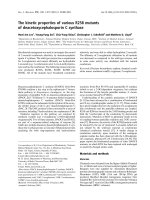
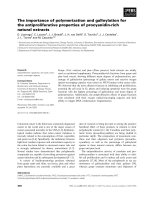
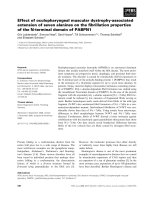
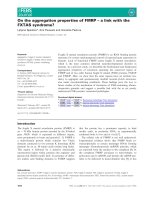

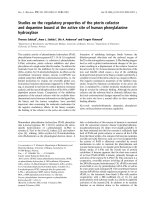
![Báo cáo Y học: The membrane-bound [NiFe]-hydrogenase (Ech) from Methanosarcina barkeri : unusual properties of the iron-sulphur clusters docx](https://media.store123doc.com/images/document/14/rc/ee/medium_eeh1395026426.jpg)